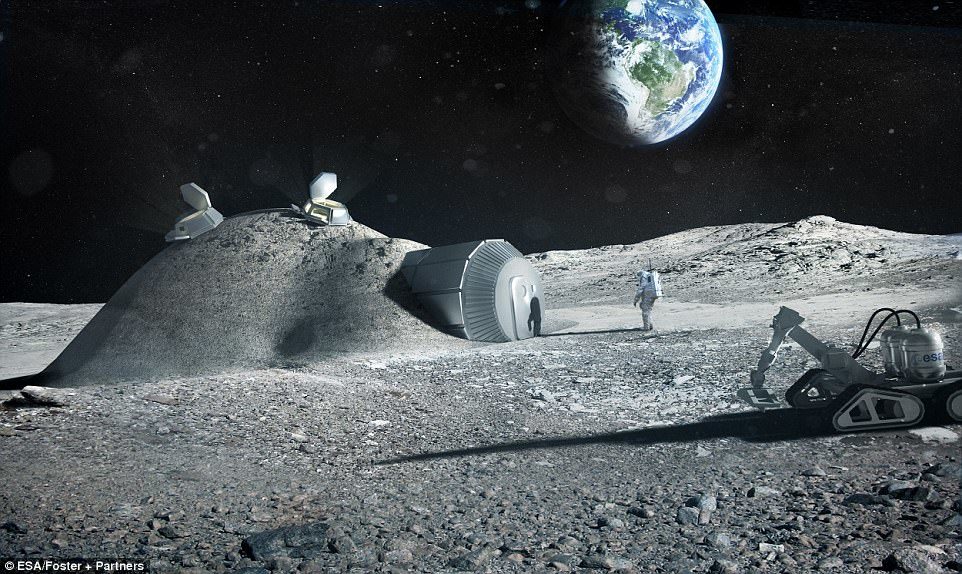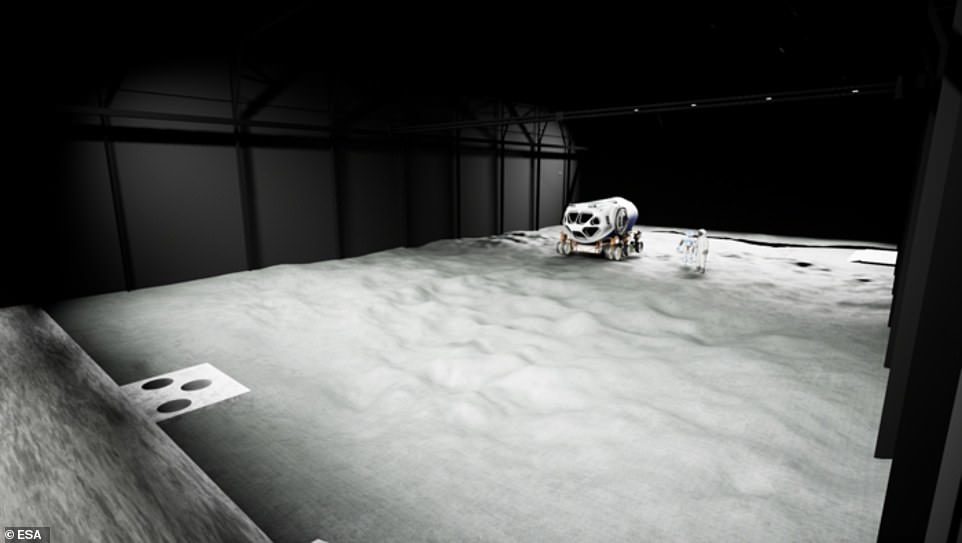
'As ESA and other agencies prepare to send humans back to the Moon - this time to stay - technologies that make use of materials available in space (in-situ resource utilisation) are seen as key to sustainability, and a stepping stone in humankind's adventure to Mars and farther into the Solar System,' the space agency said.
'In the longer term, resources in space may even be used on Earth.'
'Regolith is an ore from which it is possible to extract water and oxygen, thus enabling an independent human presence on the Moon to be envisaged, capable of producing the fuel needed for more distant exploratory missions, ESA says.
'The use of space resources could be a key to sustainable lunar exploration and this study is part of ESA's comprehensive plan to make Europe a partner in global exploration in the next decade - a plan we will put to our Ministers for decision later this year at the Space19+ Conference.' added Dr. David Parker; Director, Human and Robotic Exploration at ESA.
The mission will pit Europe against the US, Russia and China, all of whom are developing moon missions.
Last year NASA revealed plans to take America back to the moon - but will rely on private firms to run the missions.
The space agency plans to work with nine private firms, ranging from small startups to giants like Lockheed Martin, to develop robotic landers and systems to mine the natural resources on the moon.
This will help develop the technology need for eventual manned missions, and NASA Administrator Jim Bridenstine pledged to have a manned lunar base within a decade.
Ariane is hoping Ariane 64, the 4-booster version of Ariane 6, would enable this European mission to carry the equipment needed for a Moon landing.
It is also working with a German start-up, PTScientists, which will provide the lunar lander, and a Belgian SME, Space Applications Services, which will provide the ground control facilities, the communications and the associated service operations.
'This first contract - symbolically announced on the day of a lunar eclipse - is a milestone for ArianeGroup, which has for a long time been working on technological proposals for space logistics servicing,' explained André-Hubert Roussel, CEO of ArianeGroup.
'It is also an opportunity to recall the ability of Ariane 64 to carry out Moon missions for its institutional customers, with a payload capacity of up to 8.5 metric tons.'
A new facility in the works at ESA's Astronaut Centre in Cologne, Germany will soon serve as a three-part moon analogue environment on Earth, the agency announced this month.
There, scientists will simulate lunar soil and a moon habitat, powered by systems that could one day be used to support a real base on the moon.
The new facility will be known as Luna, and will take up 1,000 square meters at the Astronaut Centre.
This will pave the way for future explorations to the surface of the moon, which numerous agencies around the world are now working to achieve.
'The moon is a major focus for ESA and the next step for human exploration,' said ESA project manager for strategic planning and future development, Andreas Diekmann.
'Developed in partnership with DLR, Luna will help us build our expertise, prepare for missions to the moon and provide a platform for researchers across Europe to test technology and procedures.'
Researchers are creating a lunar dust substitute from volcanic powder produced by eruptions at the nearby Eifel volcanic region 45 million years ago.
The moon habitat known as FlexHab (Future Lunar Exploration Habitat) is intended to be operational by the end of this year.
Once it's finished, astronauts will live and work there, in a space roughly the size of a shipping container.
The space agency is currently eyeing solar energy as the most sustainable way to power operations on the moon.
'During the lunar day, energy from the Sun will be used directly via photovoltaic panels, but it will also be used to split water into hydrogen and oxygen,' ESA says.
'These two elements will then be stored separately before being recombined in a fuel cell for use during the two-week-long lunar nights.'
NASA has also recently ramped up its efforts to get astronauts back to the moon, decades after the final landing of the historic Apollo missions.
The space agency is currently planning to get humans on the lunar surface no later than the 2020s, and set up an orbiting outpost by 2023.
These goals rely on recent advances in commercial space operations and the upcoming Orion spacecraft and Space Launch System rocket.
'This will be the first chance for the majority of people alive today to witness a Moon landing - a moment when, in awe and wonder, the world holds its breath,' NASA said earlier this year.




Reader Comments
Hi, everybody.
I live on a small farm.
I grow celery.
I have heard though, that is there is better and more celery in Japan, which is across a big ocean. I live in the United States.
What I am going to do, is build a raft out of used matchsticks.
When I get back, everybody here will have better celery, thanks to me.
We all want better celery.
My journey will cost 600 billion gazillion dollars.
Please pay now, give me money and support me, so we can all have better celery.
There will be more and better celery for everyone when I get back.
We all want better celery.
nedlud,
over and out
FUCKIN' DUH.
Rumi had many stories along this line, that of fools and their beliefs. Both the swindled and the swindlers.
While you are looking for your pot of gold under that rainbow I just painted, I'll be stealing your underwear--because I can.
And in the end, none of us will have anything since all we did during our time here on earth was share lies and make counterfeit claims.
Business (aka sordid crime) as usual.
ned,
OUT